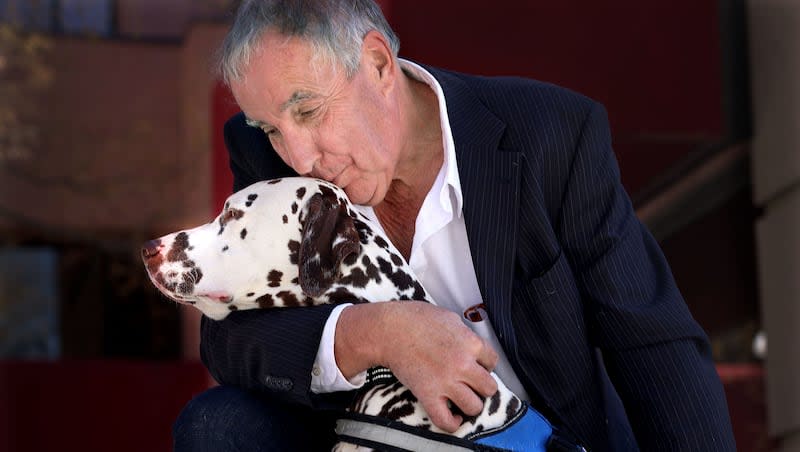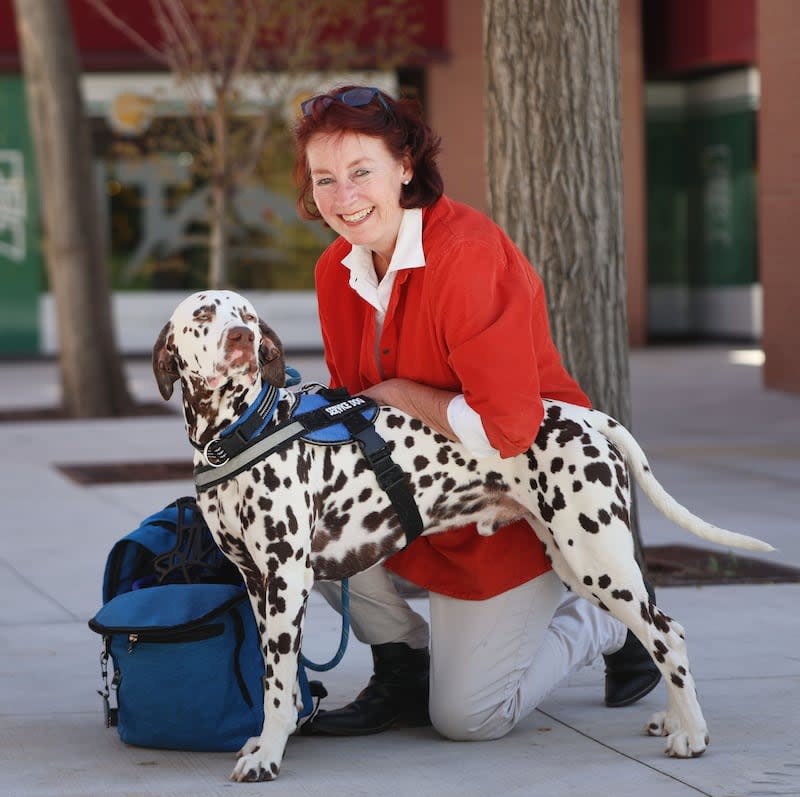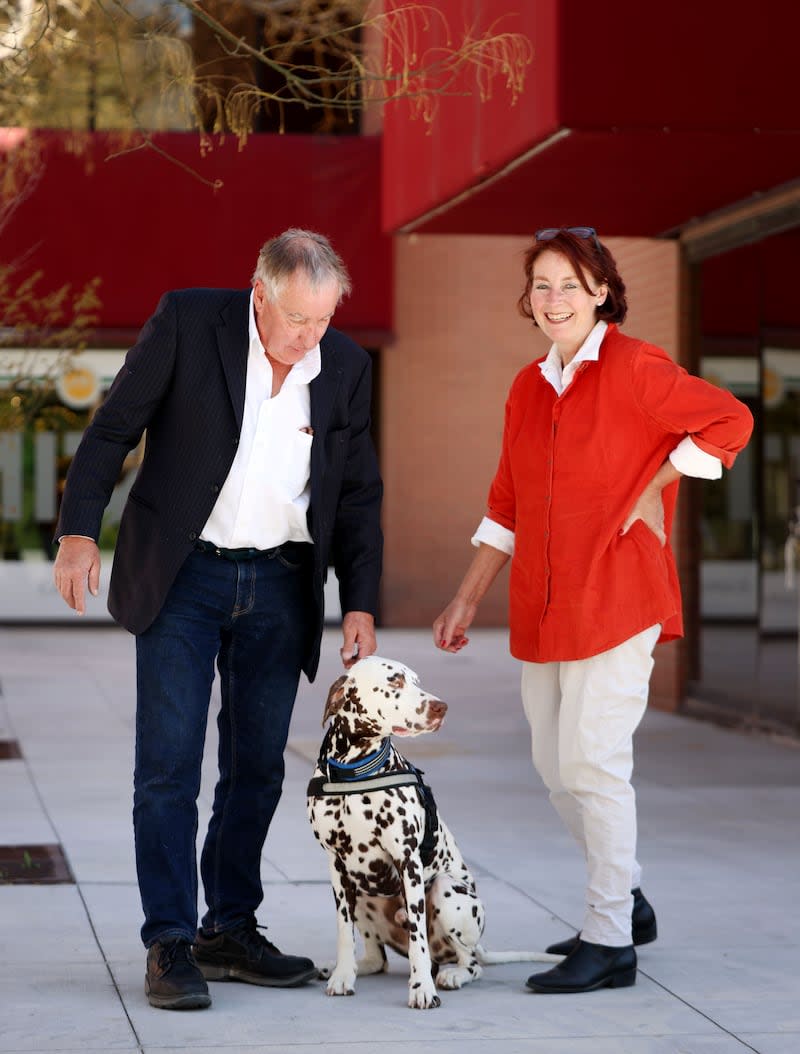Joschka the Dalmatian is on a tour touting service animal certification

Joschka, the brown-spotted Dalmatian, is welcome on planes, where, during more than 25 international flights, he’s proven he can sit quietly, put off bathroom breaks and mind his own business better than some of the human passengers. The psychiatric service dog has been trained to do all that and more so he can travel with Till-Mathias Jürgens, whose own flights are much smoother now that Joschka comes along.
Joschka is trained to European travel standards, something required of European psychiatric service dogs if they want to fly from place to place. That can be a nasty surprise for Americans flying from the U.S. to a final destination in Europe with a psychiatric service dog. As long as they meet the limited service animal requirements under the American Air Carrier Act, U.S. service dogs can fly in the airplane’s cabin from the U.S. into Europe — but the first stop is as far as they can go in the cabin. If, for example, the plane has a layover en route to Italy, the dog’s not cabin-approved for that second leg. Most airlines require European-standards certification.
Nor is a return trip to the U.S. in the plane cabin guaranteed if airlines require certification.
Jürgens and his wife, Meike Wolff, originally from Hamburg, Germany, don’t think that’s a bad idea. While in general welcoming people with service dogs is “very, very good,” Wolff told the Deseret News, “we often see that a lot of the dogs are not really trained” to high standards. That, she adds, spoils the privilege for a lot of other people who need a psychiatric service dog and have made the effort to train it properly.
That issue is, in fact, why they’re in Utah right now. The couple are here establishing PSD-USA, a branch-off of PSDeurope, a certification program ensuring psychiatric service dogs (that’s the PSD part of the name) are properly trained and can prove it by meeting a set of international and European standards of canine behavior. The certification targets travelers so that dogs can meet the tougher standards used to fly in Europe.
With that certification, the dogs can fly in the plane cabin throughout much of the world, the couple said. Joschka, 3, is an old hand at that.
What a service dog is — and isn’t
Psychiatric service dogs are not emotional support animals, which are no longer allowed inside plane cabins in the U.S. Service dogs are different, no certification required. Those canines are trained to perform specific tasks to aid their humans, providing an actual service. There are many types of service dogs, not just psychiatric ones. A nonpsychiatric service dog might sense a seizure coming on and take action to keep his owner safe or be trained to help someone with diabetes, for instance.
A longtime TV journalist, Jürgens traveled for many years without a dog, but started developing debilitating anxiety to the point it jeopardized his work. Joschka was trained specifically to meet Jürgens’ needs and keep air travel possible. A service dog’s training is tailored to what helps its human handler. But in Europe, it also has to demonstrably meet a set of travel and other requirements to gain certification.
“PSDeurope was founded with the goal of showing people with mental health diagnoses how they can continue to travel together with their dog, which is part of their treatment,” said Dr. Beate Pottmann-Knapp, a psychotherapist who has worked with human-animal duos in treating mental health patients for more than 15 years and heads the organization in Europe. “We have developed a program that is now accepted by many airlines not only in Europe but worldwide.”

By email, she wrote that airlines in Europe only recognize assistance dogs — that’s what Europe calls service dogs — if they meet certain standards. “The dogs must learn how to behave unobtrusively throughout the journey, carry out the owner’s commands and support the owner in mastering the journey mentally. To do this, the dogs learn special tasks that alleviate the owner’s psychological complaints and symptoms, alert them and reduce stress.”
Proper training, she said, makes the duo “secure and stable.” The owner learns how to lead the dog, recognize that the dog itself can experience stress that must be helped and move confidently as a team throughout a travel journey.
Which brings the story back to Joschka, who Jürgens describes as “a very good fellow — very well socialized, very friendly to every other animal.” The Dalmatian is trained to satisfy the limited requirements of the U.S. Department of Transportation and Air Carrier Access Act and then to meet the stricter European and other standards of international travel.
Making international standards uniform
Wolff believes that in time those standards will — and should — become more universally implemented. Even cruise ships are “getting in touch with this subject more and more, because there are more people” with service animals. She noted that as people age, they may develop issues where a dog provides significant help with daily life. And mental health challenges have been increasingly recognized internationally among different age groups.
The two believe people should never be excluded from public life, but they are adamant that all service animals should be properly trained so that their behavior is consistent and can be reliably counted on. To do less jeopardizes acceptance and safety. They think it’s time to certify U.S. psychiatric service dogs to the same standard that exists in Europe.
Certification is for the canine’s safety and comfort, too, so the duration of long international flights are not spent in a cargo hold where the animal can’t be taken care of or might be traumatized in some way, said Wolff, who advocates “rules and regulations. Bring everybody in a position to feel comfortable with traveling the way they do,” she said, pointing to Joschka and Jürgens.
While there is no certification required for service dogs in the U.S., this husband and wife are overseeing expansion of PSDeurope through PSD-USA, with a certification program that will allow U.S. dogs in the cabin on that second leg in Europe or other international destinations. The nonprofit corporation offers certification for psychiatric service dogs that meets the U.S. Department of Transportation and the Air Carrier Access Act rules, the tougher European accessibility act rules, the official International Air Transport Association recommendations and the requirements of major international airlines. The testing and certification ensure the dog won’t be spooked by the people-mover sidewalk or a trolley in an airport, can demonstrably go without relieving itself on a flight, can fit in small places and make it through security without incident, among other things.
The organization teaches dog owners what a dog must be able to do, provides training videos and advice, access to others who’ve been there to answer questions and problem-solve, and, finally, actual certification by an expert.
The program is new enough in the U.S. that just roughly 15 dogs have been certified, with others in the process of training to meet the tougher standards. Nor are they the only organization promoting more consistent training for travel. Jürgens and Wolff believe that’s a good thing, not only for traveling canine-human pairs, but for the people with whom they share a plane and airport.
More information is online at psd-usa.org.


